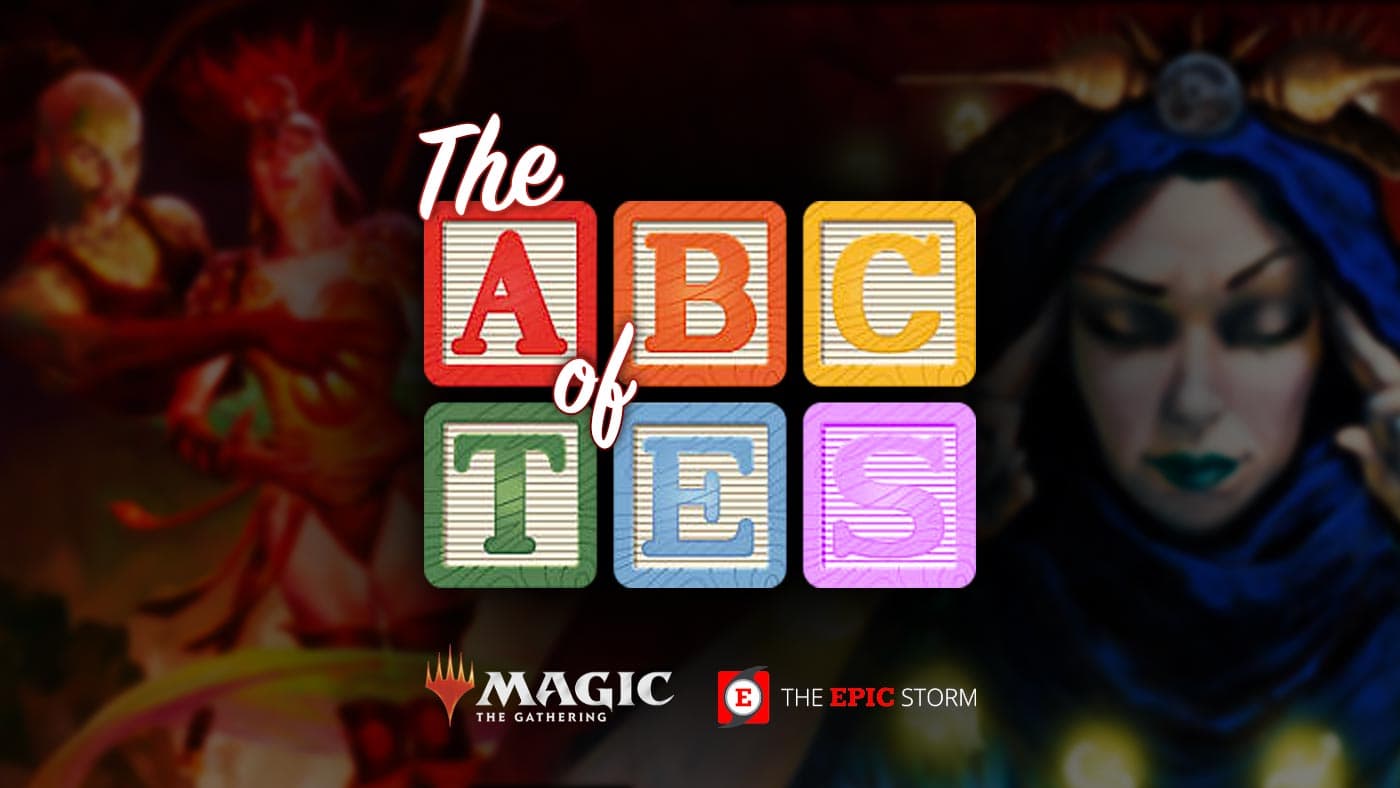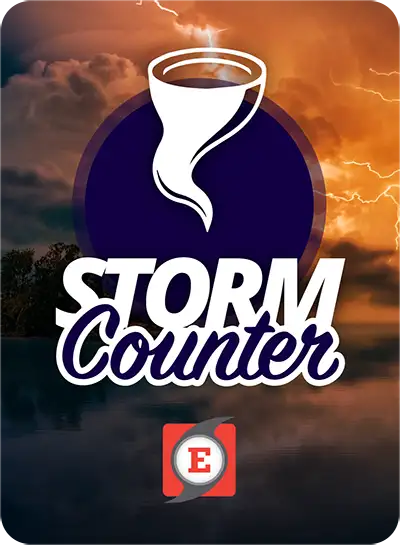Welcome to The ABC's of TES! After the addition of [[Wishclaw Talisman]] in late 2019, The EPIC Storm (TES) changed so greatly that lots of the beginner materials no longer applied. This article series is an introduction for new players to the deck and even if one has been playing for a while, there will be a new trick or two!
The EPIC Storm
(TES) is a deep and complicated deck that is rewarding to learn and play. It has the potential to win on turn one and grind out wins deep into the game. At its core, TES is a Storm deck based around [[Ad Nauseam]]. In recent years, the deck has adapted to a number of new cards that it can win the game through.
Terminology
As with Magic itself, terms come up to define common play patterns or groups of cards. These terms tend to be used often in discussions of the deck and its strategy.
Engine – A card that TES uses to generate card advantage. Examples include [[Ad Nauseam]], [[Echo of Eons]], and [[Galvanic Relay]]
Initial Mana Source – A card that is capable of generating mana without having any other mana available. Examples include [[Lotus Petal]], [[Chrome Mox]], [[Mox Opal]], and lands.
Combo Turn – The turn in which one attempts to win the game or resolve an engine card.
Protection – A card that prevents an opponent from interacting with a combo turn. Examples include [[Veil of Summer]] and [[Defense Grid]].
Perfect Brainstorm – A [[Brainstorm]] that is then followed by a shuffle effect such as a fetch land.
Net Mana – The amount of mana a card makes minus the mana cost of the card.
Wish Target/Wish Board – A card or set of cards in the sideboard that can be found with [[Burning Wish]].
Cantrip – A card like [[Brainstorm]] or [[Ponder]] that provides some amount of card selection while replacing itself.
Why Play The EPIC Storm?
[[Dark Ritual|]]
[[Veil of Summer|]]
[[Rite of Flame|]]
In years previously, the explosive nature was the biggest draw to The EPIC Storm. One may have heard the meme
"Black Belcher" thrown around, but this is not the case with modern TES builds. TES prides itself on being the best at beating blue decks through a protection suite of [[Veil of Summer]], [[Defense Grid]], and sometimes [[Orim's Chant]]. These effects are hard for blue decks to maintain parity with, as each requires an answer immediately. Given the high presence of [[Force of Will]] effects in the format, each piece of protection can trade two for one, running blue opponents out of cards. Given that fair blue decks tend to be the most popular at MTGO events and large paper events, having a good blue matchup is crucial to doing well in a tournament. TES can also still pull off blazingly fast wins before hate permanents come down against non-blue decks.The EPIC Storm is also just fun! It can do ridiculous plays and wiggle out of impossible seeming positions. Drawing half of the deck with [[Peer into the Abyss]] feels so powerful, and rightly so. One of the newest cards to the deck, [[Galvanic Relay]] is essentially just [[Necropotence]] in red. Playing perfectly
(with the help of this primer series) and pulling off an unlikely win is on of my favorite experiences and keeps the deck fresh after years of play.
(adsbygoogle = window.adsbygoogle || []).push({});
Core of The EPIC Storm
[[Ad Nauseam|]]
[[Lion's Eye Diamond|]]
[[Tendrils of Agony|]]
[[Ad Nauseam]] is the most important card in The EPIC Storm – the deck would not exist without it. Resolving an [[Ad Nauseam]] at a healthy enough life total wins the game most of the time. Many of the deck building decisions are made with this card looming over them. Looking at the deck list, there are so few expensive cards and lots with a mana value of zero. This is to reduce the average mana value of the deck as much as possible to attempt to
"draw" more cards with [[Ad Nauseam]]. This is why TES is also a [[Burning Wish]] deck. [[Burning Wish]] gives access to expensive sorceries that would otherwise be a liability to [[Ad Nauseam]]. These sorceries in the Wish Board can range from extra engines, win conditions, or expensive removal spells.[[Lion's Eye Diamond]] is a weird Magic card. It was printed as a call back to [[Black Lotus]] with a hilarious drawback, one has to discard their hand to activate it and can only activate [[Lion's Eye Diamond]] at instant speed. There are still lots of ways to exploit [[Lion's Eye Diamond]] within the rules, however. Normally, mana abilities can be activated after putting a card on the stack in order to pay costs for it. [[Lion's Eye Diamond]] cannot do that and thus cannot cast a card from one's hand. The best way to get around this is to
"hold priority". Magic is governed by a priority system and after activating a spell or ability, each player gets priority before that spell or ability resolves, starting with the player whose turn it is. In tournament Magic and Magic: The Gathering Online
(MTGO), this is
"shortcutted" to the active player immediately passing priority because it is so rare to respond to one's own spell. In paper, one must say that they are holding priority and then cracking the [[Lion's Eye Diamond]] in this window if they are responding to an effect. On MTGO, holding control while casting another spell will hold priority and allow one to activate the [[Lion's Eye Diamond]] in response to that spell. The reason that this is useful is because one can hold priority after casting a [[Burning Wish]] and use the mana from the [[Lion's Eye Diamond]] on the spell that [[Burning Wish]] finds. This also works with [[Wishclaw Talisman]], though one could just activate [[Lion's Eye Diamond]] before activating [[Wishclaw Talisman]]. The other main way to abuse [[Lion's Eye Diamond]] is to use it to discard [[Echo of Eons]] to cast it for its
flashback cost much more easily. The EPIC Storm Team sometimes gets questions about replacing [[Lion's Eye Diamond]] for budgetary reasons. Unfortunately, the card is so integral to the strategy of the deck that it is irreplaceable. TES has many was to turn the card into [[Black Lotus]] and almost [[Black Lotus]] is still a powerful card.One might notice that the cards that literally win the game for The EPIC Storm have not been mentioned yet. Once one draws enough cards and makes enough mana, winning the game tends to be trivial, as card and mana advantage tend to move the game in to a more winning state for that player. [[Tendrils of Agony]] is the best way to convert these advantages to winning the game. Sometimes, TES is thought of as an [[Empty the Warrens]] deck, which has never really been true. Most games are won through a [[Tendrils of Agony]] eventually. [[Empty the Warrens]] is a nice back up option if a game goes wrong or if there is a particular needle to thread with it.
Engines
[[Echo of Eons|]]
[[Galvanic Relay|]]
[[Peer into the Abyss|]]
One of the strengths of The EPIC Storm is that it has many different routes to victory. The primary turning points in these routes is which engine one chooses to win the game with. They are all strong in different spots and have their weaknesses, but being flexible with these options allows TES to play around hate rather than have to remove some of those lock pieces.[[Ad Nauseam]] – The primary engine of TES. [[Ad Nauseam]] is a life total-based engine, which means that it is better the more life one has. That is the primary drawback of the card. Against aggressive decks, [[Ad Nauseam]] can be
"shut off" very quickly. On average, one can expect to draw about one card per life before resolving [[Ad Nauseam]].[[Echo of Eons]] – [[Echo of Eons]] is the least resource intensive and fastest engine in the deck. Given that the flashback is only three mana, all one needs is a [[Lion's Eye Diamond]] and an [[Echo of Eons]] to go off. The downside is two fold. It is the least reliable engine to win the game on the same turn and it also gives the opponent a set of new cards. Casting [[Echo of Eons]] then passing the turn is a perfectly reasonable play to gain some amount of an advantage. For a deeper dive into how to play with [[Echo of Eons]], check out this older
article![[Peer into the Abyss]] – This is as close to deterministic of an engine that The EPIC Storm has. Most engines involve some kind of risk, but the odds of not winning the game after resolving a [[Peer into the Abyss]] are incredibly low. Despite [[Peer into the Abyss]] cutting one's life total in half, it is not really a life total based engine. It draws the same number of cards no matter what one's life total is before it resolves. The reason why [[Peer into the Abyss]] is not the primary engine in the deck is because it is so expensive. Generally, it costs nine mana total
([[Burning Wish]] into [[Peer into the Abyss]] which is a lot more mana than any other line in the deck. Because of the cost, [[Peer into the Abyss]] is not always available as an option when there is a window to win the game.[[Galvanic Relay]] – The newest engine to The EPIC Storm. Despite being only three mana, this card is inherently a slow engine because it requires a whole extra turn to get access to the cards it draws. The advantage is that each copy of [[Galvanic Relay]] draws a card, making it resilient against decks with counter spells. For a detailed read on how best to use [[Galvanic Relay]], check out this
article!
Moving Forward
This article series will continue every month in 2022. It will cover every aspect of The EPIC Storm, from how to count mana, to sequencing, how to play around an opponent's cards, and more. As you are learning the deck, I am always happy to answer questions in our
Discord and especially in the
Patreon!










